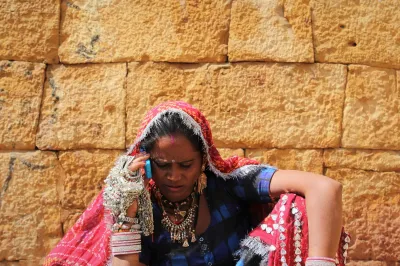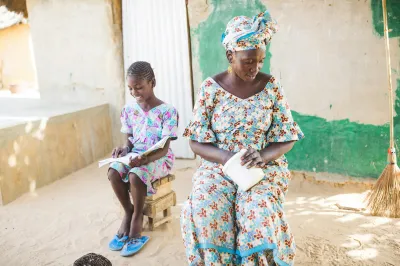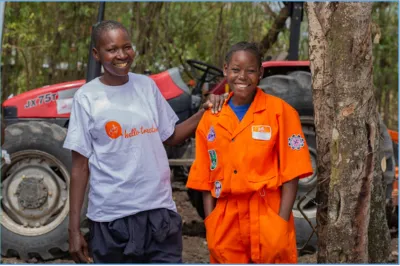Time Is Money: Financial Services Can Help Rural Women Save More of It
Rural women play a growing role in agricultural systems around the world. In low-income countries, 79% of working women report that agriculture is their primary work activity. Yet rural women often have limited opportunities to improve their livelihoods. While there are many factors at play, one of the biggest challenges that rural women face is that they lack one of the most valuable resources there is: time.
“Time poverty” refers to the chronic lack of time – after engaging in necessary or expected duties – to pursue discretionary activities. For rural women, this can mean participating in income-generating activities or education.
This is a common problem for rural women, mainly because social norms in many countries dictate that women should be primarily responsible for unpaid childcare and household responsibilities. In fact, FAO research in nine African Union countries reveals that women’s workdays are up to 50% longer than men’s.
Below are three ways financial services can help to alleviate time poverty among rural women.
1. Improve rural women’s access to time-saving assets and financial solutions
RAFLL research (forthcoming) suggests that rural women enjoy less social mobility than men and that their advancement depends on their ability to make both capital and time investments in their farms or businesses.

Given the amount of time rural women spend on unpaid labor, they have a particular need for productive and time-saving assets and services to realize their full economic potential. Yet women do not have the same access to these resources that men do. Women are less likely to own land, to adopt improved agricultural inputs and technologies, like tractors and solar water pumps, or to profit from returns to labor and access to markets. Globally, this gender gap means missing out on an opportunity to increase agricultural yields by 20% to 30% and to reduce the number of hungry people by over 15%. It is also one of the reasons why rural women are disproportionately impacted by poverty.
Financial services can provide a solution. Loan products that align disbursement and repayment schedules with women’s seasonal crop and cash-flows can help women finance time-saving assets, such as farm equipment, or hire farm workers. Technology-based solutions can also help women circumvent some of the educational, sociocultural, and legal barriers impacting their use of time while simultaneously making them more financially included. For example, digital marketplace lending platforms, including peer-to-peer and crowdfunding solutions that connect borrowers with investors; social safety net cash transfer programs; and wage and utility bill payments allow women to overcome mobility barriers and spend less time collecting paychecks. Female agent banking models, where agents visit beneficiaries’ homes to collect and distribute payments and facilitate access to non-financial services, such as advisory services or access to markets, can also benefit rural women who face mobility and time barriers.
Innovations in asset finance also represent an opportunity to help more rural women access productive or time-saving assets tailored to their needs. Asset finance providers around the world are leveraging an array of emerging business models to increase low-income households’ ownership of assets like home solar systems, cookstoves, tractors and smartphones.
2. Promote more egalitarian norms around gender roles
Gender norms concerning household responsibilities and labor segregation have a profound effect on women’s time. Traditional norms built around men’s “breadwinner” role and women’s caring duties reduce rural women’s freedom to choose how to allocate their time and resources, trapping them in cycles of poverty. When rural women’s personal aspirations conflict with their family obligations, it is often difficult for them to engage in paid work, invest in their education, conduct business at peak hours or reach bank branches outside their village.
Vocational education and training opportunities for women and men that blend group discussion, role-playing and hands-on activities, like the ones provided by Promundo's Program P, help promote more egalitarian norms. Financial services providers can play a role too. For instance, they can help promote joint financial decision making; tailor financial products to women’s needs, constraints, and ambitions; and link these services with financial literacy toolkits that increase women agency and control over resources.
Providers may also explore partnerships with development organizations like the World Food Program (WFP) that send e-vouchers to women who attend vocational skills and literacy trainings, incentivizing them to open e-money accounts. To overcome barriers that prevent women from attending trainings, providers must design these opportunities through a gender-inclusive lens. This may include covering the cost of participating and providing childcare, selecting convenient locations and times for workshops, and supplementing in-person training with a digital option.
3. Increase access to formal and informal childcare support and networks
In addition to more egalitarian norms around household responsibilities, women can benefit from greater support with childcare responsibilities. Forthcoming RAFLL data reveals that women place a higher value than men do on having access to an informal network of friends, family and community members to help them save time by sharing caregiving responsibilities. For example, the lack of social services in Ghana obliges many women to rely on quasi-formal networks like the Makola Market Childcare Centre, which is run by a parent-teacher association.
A study by the Gender Innovation Lab conducted in rural households in Western DRC shows that subsidized childcare has the potential to shift women’s time-use patterns and increase their economic productivity. But in countries where subsidized or employer-provided childcare is not the norm, it is important for women to be able to pay for childcare support. Alternative credit risk assessment mechanisms for low-income women and bundled financial solutions, such as savings, credits or insurance, can address the lifecycle needs of women and enable them to take care of many financial needs, including paying for childcare.
More research is needed
There is a need for funders and researchers to improve the financial inclusion community’s understanding of how time poverty impacts women at different stages of their lives. A recent IFPRI paper uses a promising approach that looks not only at how much time women spend on various activities, but at the strategic choices they make about how to allocate time (their “time-use agency”). Building on this, the Measures for Advancing Gender Equality initiative will be developing new tools to measure how women use their time and discover time-use patterns.
Similarly, more research should be done on how the development community can integrate a gender lens into recovery efforts, especially in times of crises. Indeed, wars, environmental shocks, or health emergencies like the COVID-19 pandemic often exacerbate the effects of time poverty on women, whose unpaid workloads are amplified and who, as a result, are often obliged to give up paid work.




Add new comment